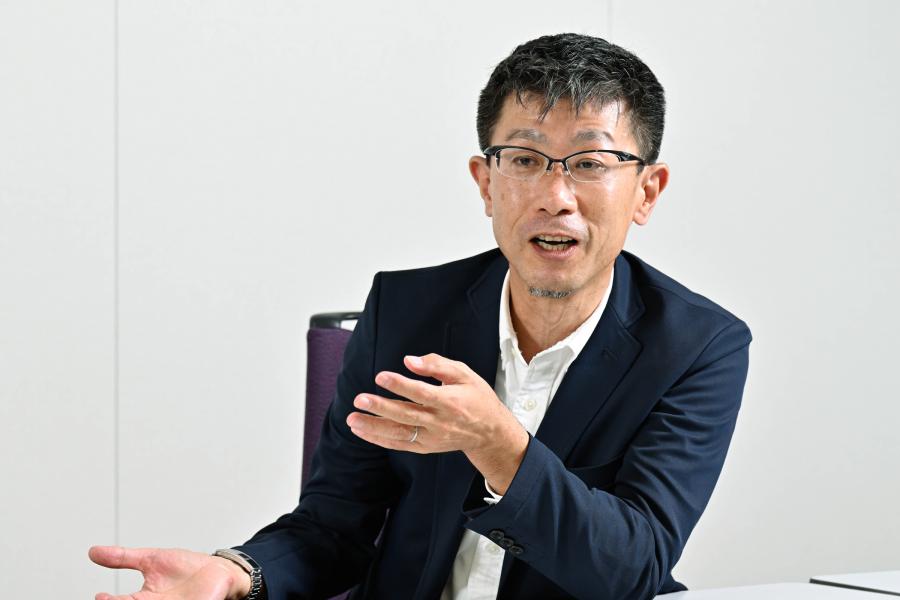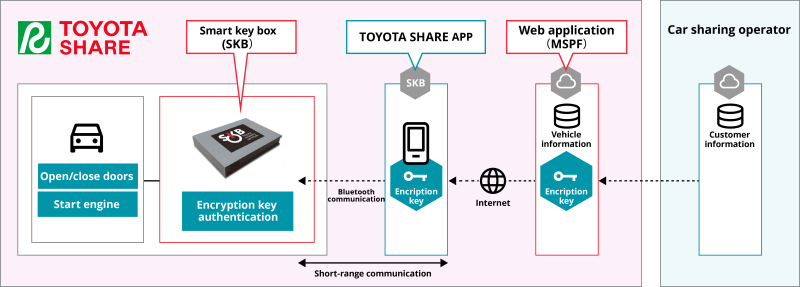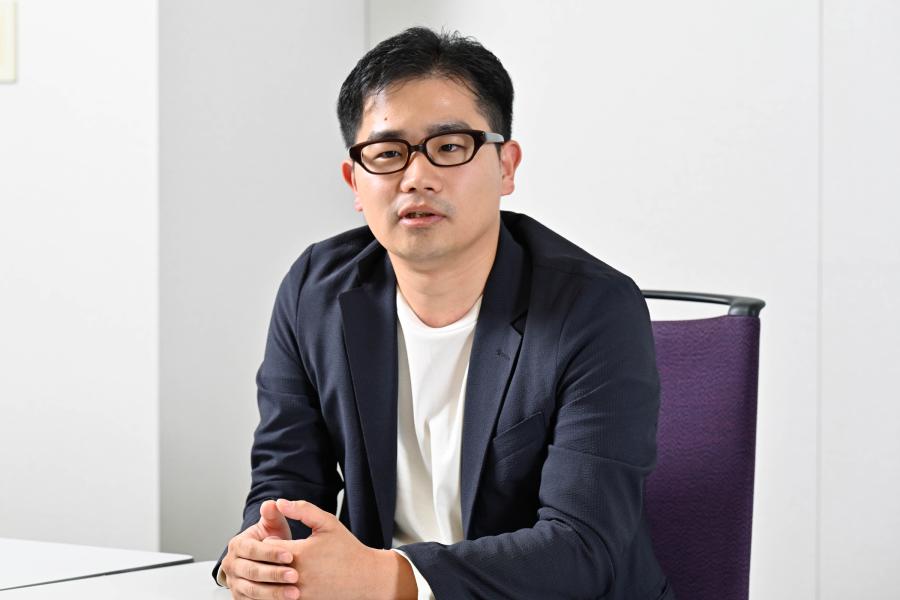Toyota Motor Corporation faces an array of challenges as it undergoes a full model change into a mobility company. Technology in the connected, automation, sharing, electrification (CASE) field and various mobility-related services that apply this technology are rapidly progressing across the company. One of these services is TOYOTA SHARE, a car sharing service that utilizes connected technology—a sort of IoT for cars.
Atsushi Mizuno, Head of the System Development Group in the MSPF Planning and Development Office, MaaS Division, CV Company, says: "TOYOTA SHARE is steadily gaining popularity as a car sharing service that allows you to complete all steps of a car reservation, including usage and payment, with a single smartphone app. Users particularly like the ‘ease of use’ it provides by ‘turning your smartphone into the keys to your car.’ With the renewal, we have expanded the number of stations and vehicles that can be used, making it even easier to complete reservations in as short as 15 minutes in advance to as long as one month prior."
The MSPF Planning and Development Office System Development Group is responsible for the development and operation of smartphone apps and web applications that support TOYOTA SHARE, as well as data analysis. It is one of the front-line units responsible for transforming Toyota into a mobility company.
“TOYOTA SHARE began as a service in October 2019. Since then, we have refined our customers' service experience while pursuing convenience, comfort, and safety as a car sharing service in a way that only Toyota, an automobile company, can provide. It has not been a smooth road, but we are steadily making progress, including the receipt of high ratings in customer satisfaction surveys," says Mizuno.

Toyota Motor Corporation CV Company, MaaS Division, MSPF Planning and Development Office, System Development Group Manager, Atsushi Mizuno
How the smartphone app makes TOYOTA SHARE easy to use with a better user experience
"A major feature is 'digital key technology' that allows customers to use their smartphones as car keys. We achieved this by incorporating a smart key box (SKB), which is an in-vehicle device that allows you to control door unlocking and locking, as well as engine starting, from the app. Without the need to hand over a physical key, it makes it possible to use car sharing services 24 hours a day. During the renewal, we significantly strengthened our systems and introduced the observability platform New Relic to prepare for new business growth," says Mizuno.
Edge environment: Where smartphone apps and IoT devices interact
Three main core technologies support TOYOTA SHARE services: ① the TOYOTA SHARE app for smartphones; ② Mobility Services Platform (MSPF)—an open platform for providing mobility service providers with a range of API-based functions required by mobility services—a web application maintained on the cloud; and ③ the in-vehicle IoT device Smart Key Box (SKB). The smartphone app and web application communicate via the Internet, while the smartphone app and SKB communicate via Bluetooth.

1) TOYOTA SHARE app: Unlock/lock doors and start the engine using the encryption key downloaded from MSPF.
2) Mobility Services Platform (MSPF): A web application that issues encryption keys through user authentication based on smartphone app requests.
3) Smart Key Box (SKB): An in-vehicle IoT device that controls unlocking/locking of doors and engine start after authentication using an encryption key.
Keita Kobayashi, who leads application development in the System Development Group of the MSPF Planning and Development Office, stated that "our main goal in introducing New Relic was to more accurately understand the edge environments that consist of smartphone apps and SKB, and to immediately learn if any problems or defects that affect the user experience occur. Compared to server-side monitoring environments, the edge-side monitoring environment had never been satisfactory."

Toyota Motor Corporation CV Company, MaaS Division, MSPF Planning and Development Office, System Development Group, Keita Kobayashi
"For example, when we receive an inquiry from a customer who uses our services, being able to understand what kind of interaction took place between the smartphone app and the SKB will help us provide a smooth response. I had high hopes for the ability of New Relic mobile to collect logs in edge environments,” says Kobayashi.
There are many use cases for monitoring IoT devices with New Relic Mobile. However, this was the first time that it had been applied to Toyota's proprietary smart key box (SKB). "First, we conducted a feasibility study with the help of the New Relic technology team. The two points verified were: 1. Can New Relic mobile reliably retrieve SKB logs?; 2. Can SKB logs be reliably sent to New Relic and visualized under conditions where communication is unstable due to moving cars?” says Kobayashi.
Collecting logs and visualizing n-vehicle IoT devices
By incorporating agents into smartphone apps, New Relic mobile can monitor app operation and error status, app communication time and results, and more. The unique challenges for this project are log collection and real-time visualization of the SKB on the smartphone end.
Kobayashi says that "by using the SDK functionality of the New Relic mobile agent built into the TOYOTA SHARE app and making minor modifications to match SKB specifications, it is now possible to obtain logs of communications and operation between the required application and the SKB. We also confirmed that even if internet communication is disrupted in a mountainous area, the collected logs are sent to New Relic once communication is restored and can be visualized in real time."
If a problem occurs due to specific conditions, such as the smartphone model or OS version, it is easy to resolve. However, on very rare occasions, problems that had no identifiable cause or could not be reproduced occurred. Toyota's thorough commitment to quality in car manufacturing continues with TOYOTA SHARE.
Stating his expectations, Mizuno says that "with the introduction of New Relic mobile, we now have a system in place that allows us to understand the situation in real time when something goes wrong in our edge environments. We have been working to improve quality based on the “genchi genbutsu” (going to the source to get the facts) concept, but by combining this with more effective methods, we will be able to improve the quality of TOYOTA SHARE more efficiently."
New Relic mobile's edge environment log collection and analysis has shown remarkable results in improving the efficiency of inquiry response. Ryosuke Tanimura, who is in charge of data analysis in the System Development Group of the MSPF Planning and Development Office, says:
"For example, we were able to reduce the time required to respond to SKB inquiries from car dealers by approximately 60% per month. Additionally, the time required for customer inquiries regarding the TOYOTA SHARE app has been reduced by approximately 25%. In the future, as we become more familiar with New Relic, we will accumulate knowledge about past cases and how to deal with them, and we hope that response time will be further reduced."

Ryosuke Tanimura, System Development Group, MSPF Planning and Development Office, MaaS Division, CV Company, Toyota Motor Corporation
Currently, the support center is the primary point of contact for inquiries regarding TOYOTA SHARE services. If a problem is difficult to resolve, it is escalated to the System Development Group that handles New Relic.
“In the future, we would like to allow support center agents to directly view the New Relic dashboard. This should greatly reduce response time,” says Tanimura.
Sharing user experiences and improving services from a customer perspective
As the use of New Relic mobile progressed, it became possible to quantitatively understand the usage status of the TOYOTA SHARE app. This has led to changes in decision-making within the MSPF planning and development department.
Tanimura continues, "I feel that our mindset and actions have changed from the perspective of creating a product called TOYOTA SHARE to creating a better user experience. Our policies for development and maintenance have become clearer, and we have statistically discovered and prioritized frequently used features with the help of New Relic's telemetry data. This enables us to start reviewing rarely used features. Another important point is that we can now focus on developing functions that we expect to be more effective. We also hope that using New Relic during the testing phase will increase development productivity."
Adoption of New Relic for web applications and service infrastructure built on AWS is also beginning.
"Implementing New Relic on the server side was easy. We've already confirmed that we can get the information we need. In the future, we would like to be able to view the entire TOYOTA SHARE service from a bird's-eye view, understand the operating status and performance of the app, and identify the cause of any malfunction in real time. We will take full advantage of New Relic's inherent ability of end-to-end observability,” says Kobayashi.
As of November 2023, there are over 1,200 stations nationwide where TOYOTA SHARE can be used. "We aim to double both the number of vehicles and the scale of our business. Preparations for this are almost complete,'' Mizuno says.
"Car dealers and rental and leasing stores have high expectations for TOYOTA SHARE as a point of contact with customers. We would like to refine TOYOTA SHARE from the customer's perspective and develop it into a platform that is even more valuable to all stakeholders, including customers. In addition, New Relic has proven able to monitor the operating status of IoT devices, and as it becomes a new weapon in the MSPF and MaaS businesses, we are beginning to see possibilities for expanding our services. We would like to thank the New Relic technology team for their efforts in getting us up and running in such a short time. We look forward to their continued advice and support," says Mizuno.




